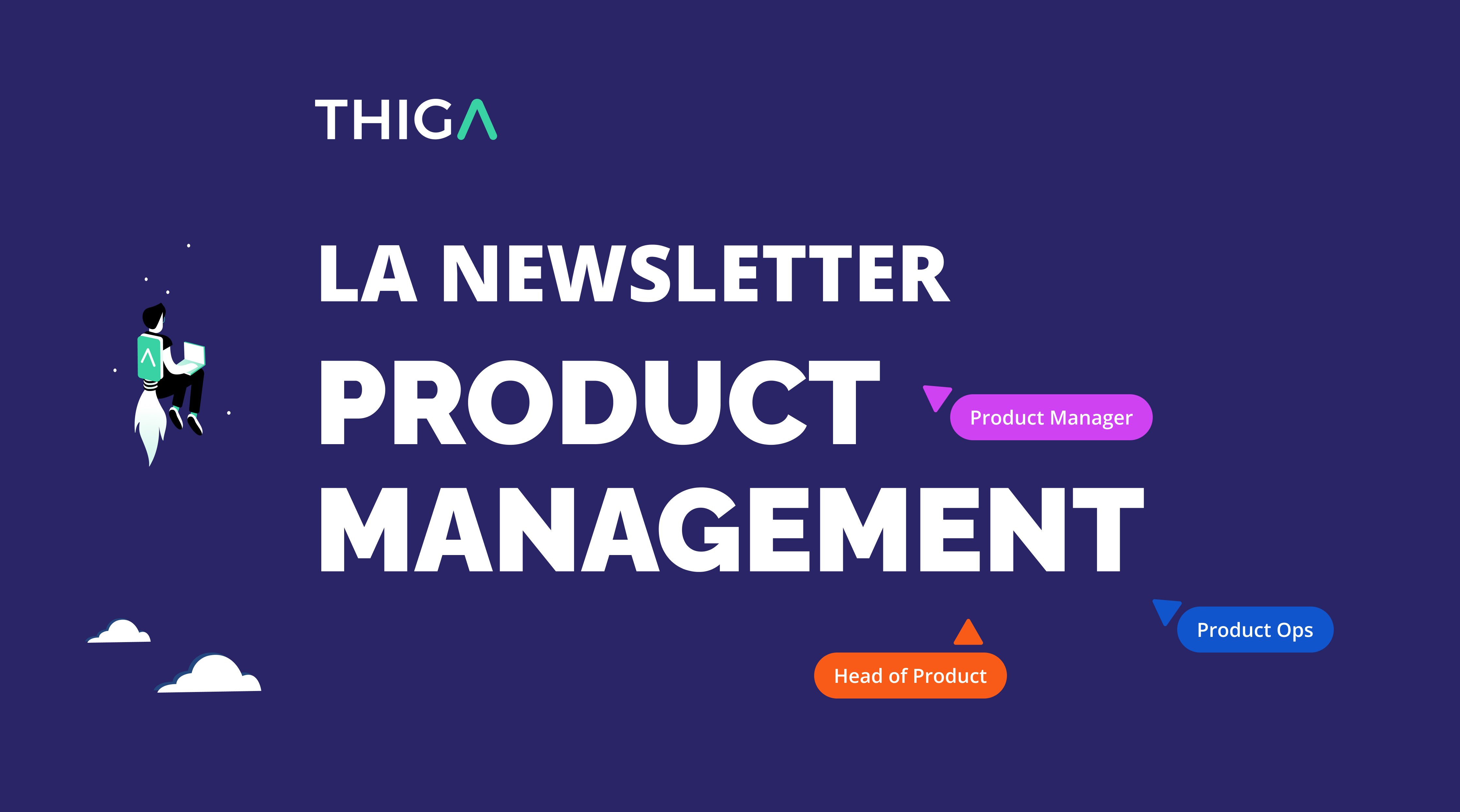Marion Darnet is the founder of Pachamama, a Product career agents collective. She’s also the co-founder of L’Avant-Garde, a community of 100 female Heads of Product and CPOs. In this op-ed piece, she rocks the boat with one single goal : to raise collective awareness.
“Yet another one of those feminists babbling about diversity. When you think about it, what’s wrong ?” I can already hear some people protesting just at the mention of this opinion piece.
They’re not wrong. What am I complaining about exactly ?
After all, people have quickly trusted me, and I’ve had a great career progression as a PM/Head of Product (HoP). It’s true I didn’t need to fight to see my wages rise as my experiences piled up. I even went through very rapid growth with teams in the United States and in Asia. I've formed great working partnerships with my peers, bosses, Lead Devs, CTOs, founders, and so on. Lastly, I've lived incredible human adventures at Wonderbox, Synthesio, and Privateaser.
So, “what’s wrong ?”
For a long time, I made do with it, as I already felt lucky “for a woman in Tech” ! Regardless of my sometimes distressing experiences in the Product world. Do you want examples ?
I remember those seminars where the Product strategy was determined without me, with a "cigars and boys club" vibe. I remember that attempted coup by a subordinate who couldn’t stand that I took the job from him. And what about those meetings where I was the only woman, and the sexist remarks that ensued ? I’ve also lost count of the times I had to state I wasn't planning on having children in order to get jobs in startups. Finally, all those questions about my looks, which sounded like hints : “do I need to play a seduction game to be recognized, invited or accepted at some strategic meeting, or even to be promoted ?"
I was 25. I was growing as a leader, but more importantly, as a person. At that time, I was trying to fit in by understanding the rules of the game, rather than trying to understand myself, including my own sexuality : what kind of woman am I ? What kind of woman in Product do I want to be ? What type of leader ? In what kind of company ? What skills do I want to develop ?
It’s because we are taught to be goody two-shoes, not to assert ourselves too much, and to keep quiet. Because the system is historically built that way.
Parity is “okay”, but only at the bottom of the totem pole
Let's now return to the broader picture with some numbers. Yes, it’s true, gender parity is more or less “okay” in Product, especially because Product Design or Product Marketing are subjects favored by women.
Looking at the latest study by La Product Conf (LPC) from Thiga, that found that the world of Product is composed of 54% males, the major problem lies at the top of the pyramid. You know, where the highest salaries are at. Where the significant strategic decisions about the company, teams, and culture are made... According to this study, Product leaders (CPO, VP Product, HoP), who have the most experience, are mostly men (63% / 35%).
Regarding the supposedly more "feminine" professions (Product Designer, Product Marketing Manager...) that have many individual female contributors, who do we always find at the top of the pyramid ? I’ll tell you : men… And what about FrenchCPO, the community of over 200 top CPOs in the French Product ecosystem ? There are only 18% women.
That’s what’s wrong !
I admit I was doubtful the first time Caroline Ramade from 50inTech shared the infamous statistic : 1 out of 2 women leaves Tech once she’s 35. I thought it was a stretch…
Since I co-founded L’Avant-Garde, the community of female Product Leaders, the reality of the field has caught up to me. Together with Emmanuelle Thomas, former Head of Product at Netatmo and now entrepreneur, we have created the community we wish we had when we became "Head of" for the first time. We had new professional challenges to face following our advancements, and no role models or women in similar positions to discuss with.
The first batch, in 2022, brought together more than 50 female leaders. They all had the potential to become the new Amandine Durr (Backmarket CPO) or Isabelle Bénard (Mirakl CPO), two role models we had the honor of hosting in our community.
Instead of carrying on climbing the ranks in Tech and Product, some choose to use their energy and their incredible talents elsewhere, to the benefit of different projects. Caroline Ducharme is a great example : pioneering co-founder of L’Avant-Garde, she left her job as a CPO to join the Climate Business Convention (CEC)
Career changes are rarely discussed in Product, which remains a popular career field. Yet, they very much exist.
Why do they happen ? Here is an example from Armelle (the name has been changed to maintain anonymity), former HoP at a B2B SaaS company, and who has now left Tech : “As Head of Product, I experienced what I call a “presumption of incompetence”. I felt like I constantly had to prove myself, especially as some organizational and strategic decisions were opposed to the Product approach. Before and after me, 3 men held the same position as VP Products, with a different pay from mine and - obviously - a presumption of competence from the start…”
Why didn’t Armelle want to continue her Product career elsewhere ? “When your company isn’t product-organized yet, you have to constantly educate people. That need for pedagogy was my main cause of weariness. That burden and the lack of recognition that came with it have had me fed up with my job”. That’s why Armelle is currently retraining in children and family law.
Yearning for impact and meaning is another reason driving women to change paths. On the plus side, some of them keep building their Product career while seeking more positive impact. I’m thinking of Julie Beaujoin Prieur, former CPO of Happn, who took risks by joining a very small startup working on an impactful product, meant for DYS children. I’m also thinking of Marion Turbet, former CPO of Epsor, who just joined the rapidly growing association 1001 mots.
Seeing the emergence of new leadership role models for women is the purpose of L'Avant-Garde.
The glass ceiling isn’t a myth
Several reasons are often given to explain the lack of women in Tech :
- Gender stereotypes play a significant role from an early age, influencing interests and career choices. Tech, originally an engineering world, is often seen as a male domain, which can discourage some women from pursuing a career in it.
- The lack of successful female role models in the field contributes to the feeling that it isn’t meant for women.
- The lack of mentorship and support networks can make accessing career opportunities and professional advancement challenging.
But you know that already…
From my own experience in Product, I see that the infamous glass ceiling is still there. A promising talent in the Product world, HoP from a Next40 scaleup, cut down in her prime due to blatant sexism : “I don’t know if I want to continue with that type of leadership position or go back to being an IC (Individual Contributor) Product Manager. I love strategy and management, but I do not want to go through that again.”
For another senior Product Manager, it’s an incident involving the co-founder of a unicorn company that hindered her burgeoning career : “It was difficult to deal with although, in the end, I was the victim…And I found myself asking questions such as : “am I really competent in my role?” I just wanted to be judged on my skills, not my looks."
Having chosen to remain anonymous, this woman speaks out to expose an ecosystem not always as modern as it seems : “In Tech, you often have this impunity issue because founders all know each other very well and protect each other”. The purpose of this opinion piece isn’t to make generalizations about startup founders, but simply to expose toxic systemic behaviors that repel women.
Déborah Pillet, Product leader at Mangopay, former Quicksign employee, summarizes in the New Work City podcast (episode 43) how that phenomenon manifests itself. After a 15 years Product career, she highlights the challenges faced by the women she has encountered : questioning on the right time to have a child and the potential risks to her career (whereas men never ask themselves this question), reduction or modification of responsibilities upon returning from maternity leave, struggling against the glass ceiling to climb the hierarchy…
Another thing that I notice through my work at Pachamama, a collective of Tech, Data, and Product career agents, is that women are not as good at valuing their work. Something confirmed by Armelle, the retraining Head Of Product : “In hindsight, I realize that I did not spend enough time on marketing myself. I was in a vicious cycle, trying to make up for my management's lack of vision while doing my job well... instead of promoting myself within the company.'"
According to Sylvain Grande, the Payfit CPO highly committed to diversity and equity issues, it’s a bias : “I don’t want to fall into stereotypes - it’s always a risk when talking about these topics - and I’ll try to remain nuanced. I feel like women are less comfortable with the idea of putting themselves forward. However, the much-talked-about impostor syndrome exists as much among men, especially when one is “moving up”. The difference is that women generally tend to have more empathy and interpersonal skills. And since they’re dealing with men, it doesn’t necessarily help them. The danger is that they remain stuck in a vicious cycle.”
What if there was actually a double glass ceiling in Product ?
The first one appears when moving from an IC position to become Head of Product. For it to be shattered, women need to promote their work, their skills and to dare asking for advancements.
Then comes the second glass ceiling, when moving from Head of Product to become VP/CPO, and which is more difficult to break because it is much more systemic. The HoP of a well-know B2C scaleup shares her experience : “At this stage, highlighting one's work is no longer enough. Women are asked to master masculine codes. So, you either stay true to yourself and don't break that glass ceiling, or you mimic the behavior of men to be recognized as a leader. I am stuck under this glass ceiling because I don't want to feed my ego - as I've been asked to - nor change my behavior.”
Diversity helps creating richer products. It’s merely common business sense to have diversity in your teams, at all levels of hierarchy.
Whose fault is it then ? It would be easy to point the finger at a certain type of organization, model, or profile to explain the lack of female leaders in Tech. But one thing is certain : the company as a whole has a role to play. Need a figure ? 47% women in Tech think that their company does not commit enough to parity (Women in Tech / WebSummit 2023, + 21% compared to 2022). Companies are responsible for the products they create, so it is up to them to ensure that diversity, in all its forms, is taken into account in the creation process.
Creating successful products that will meet their markets is not a male-female issue. Sylvain Grande agrees : “'Diversity helps to create richer products because users are all on different segments. In most products, 50% of the users are women, and you can apply this to all segments and tell yourself : it’s merely common business sense to have diversity in your teams, at all levels of hierarchy.'"
Netflix has perfectly understood the link between business performance and inclusion. In its first report on inclusion (2021), the American company shares that its corporate culture, "combined with more diversity and inclusion, boosts the ability to innovate, be creative, and solve problems."
Concretely, employees are encouraged to take diversity into account to anticipate shortcomings and address them : We call this an "inclusion lens", leading employees to ask questions like : 'Whose voice is missing?'; 'Who is excluded?'; or 'Is our representation accurate ?'"
The United States is ahead of us on this subject and we have much to learn from Uncle Sam (though we also could draw more inspiration from our German or Nordic neighbors) on diversity matters. Having spent a large part of his career in New York, the PayFit CPO bears it out : “These topics are much more discussed in the US, and the more it's talked about, the more it penetrates people's minds. And you must be aware of the biases. Product jobs have existed for more than 15 years in the US and maybe 5 or 10 years in Europe. Historically, I think there's a bigger maturity gap between the United States and France in the Product area than in engineering, for instance. Even though the engineering part of "Tech" should take inspiration from Product, and Design in particular, on the topic of diversity…”
Less maturity equals less acceptance of diversity in career paths or in education. And this also penalizes women.
We must therefore go back to the source : if we want some women to reach the very top of the pyramid, we need many more at its base. Simple tools are available to reinvigorate the talent pools. Yet many French companies still haven’t adopted them. Everyone knows of them, but they require real willingness and commitment (and courage…).
Here are 5 concrete initiatives launched by companies and that work according to me. They can help increase the pool of female talents and assist them in breaking the glass ceiling :
1/ Pay Equity : This often sheds light on the fact that men are paid more than women. Companies that implement this transparency tool must increase the salaries of some underpaid women before communicating such a pay scale... Proving that it moves the needle.
2/ Career paths and advancements : introducing objectivity into career advancement opportunities ensures that women have the same chances of progressing as some men who are more comfortable negotiating or promoting their work.
3/ Flexibility : at Scaleway, Blablacar, or Decathlon, for instance, some C-level executives block their schedules from 5 PM with a “family time” note. This sends a powerful message : yes, all employees can take this time dedicated to their families.
4/ Sponsoring top female talents : when you have a high-performing and high-potential woman who wants to speak up within your company, it's your duty to support her by offering coaching, mentoring, or training in management, leadership, and public speaking, and by putting her in the spotlight.
5/ Anti-harassment and “anti-toxicity” tools : look at the incredible work being done by Egae or by Caroline Therwath-Chavier, who offers anti-bias coaching and training with The Allyance.
To break that glass ceiling, both women and men have a part to play
Ladies, let’s be more daring !
Companies do have their share of responsibility…But as women we also have our own ! We must be the primary agents of change.
From my experience in the field, here’s what makes the difference between women who apply for and obtain C-level positions, and the rest.
Knowing how to promote yourself doesn’t imply doing politics. It’s part of the job ! A top female CPO of the French ecosystem recently told me : “I have a PM in my team who is really outstanding. But she doesn't know how to market herself. As a result, less capable men get ahead of her to secure the best scopes and internal visibility. I coach her more on these aspects than on the Product part itself.”
Beyond sisterhood 🫶, the key lesson is : “Don’t wait for someone to grant you legitimacy.” No one will. Go get it and be confident about it !
Playing the boldness card. That's what CPO of Malt Belén Alomar Brutau did, pulling off reaching managerial positions in Product without ever having been an “IC” Product Manager in the past. It’s a feat in itself when you’re in an ecosystem as shut off to that type of career path. Her motto is the same as ours at L'Avant-Garde : "Be bold." Belén shares : "Don't look at job descriptions before applying. Had I done that, I would never have applied [at Malt] because I didn't meet any of the basic required criteria. I relied on an external headhunter who was able to highlight my profile, talk about my personality, and convince the founders to meet me."
However, of course, that alone is not enough. The female CPO aced the interviews and the case study to outperform all other candidates and get the job, relying on her strong personality and her experience in consulting, strategy, and business.
“Business” isn’t a dirty word. In fact, it’s a career booster underused by women. That’s the other main difference that I see with those who climb the ranks in Product, they take interest in the entire cycle : market, growth loops, Product-Market Fit, Product Marketing of course, but also the commercial side, the pricing, and P&L. Knowing how to build profitable products is the key to placing Product at the center of organizations. Ladies, it's time to learn to talk business, to interact with all your stakeholders. And to love doing so !
A self-confidence boost ? When I ponder about what distinguishes women with incredible career paths from those who have hit their glass ceiling, something stands out : they’re more carefree. They’re more daring.
Mangopay Product Leader Déborah Pillet agrees : “We need to tell women to dare. And for the most motivated, to speak up ! We must transform everything that annoys us in the current system into positive energy."
According to Mathilde Collin, Front CEO, it's rather a lack of self-confidence. Here's what she shared with Maddyness in January 2024 : "I've been investing in startups for 7 years and in my eyes, when all else is equal, it's our level of self-confidence that kills us. The difference in this regard is quite striking between men and women. So, my motivation is to inspire others. But I think we're on an upward slope. There are plenty of women launching in Silicon Valley, for example. And we mustn't forget that companies managed by women are economically more efficient; they tend to spend less."
Gentlemen, we (also) need you
All stakeholders must commit in order to build a new paradigm. Naturally, men have a key role to play in reaching a new balance.
With Pachamama, I regularly come across men who are creating startups and who are specifically seeking female co-founders at the launch of their projects. I support them, particularly by opening my network to them.
We need proactive men. They shouldn’t hesitate to go after female talents !
I also see male CEOs who are keen on rebalancing their executive committee or board of directors, or even the gender ratio in their sector (industry, construction, fintech, insurtech, etc.) by specifically seeking out female talents.
Though I might reignite the debate on positive discrimination, I think it’s awesome. Why ? Because diversity is an issue that requires work, and these men have understood that the outset is crucial.
The earlier diversity is implemented, the easier it is to foster afterwards.
Conversely, I am frustrated to see post-Series A startups (at the time of their structuring phase and the creation of the core of the Tech, Data & Product team, for example) giving up on recruiting female talent before even trying...
When a startup ends up having more than 10 developers on a team and not a single woman, hiring female talents - including in Data and product - will become more challenging over time because women may not feel “safe” and may not take the risk of joining such a team.
We need proactive men. They shouldn’t hesitate to go after female talents !
At PayFit, there is an internal initiative called “Women @PayFit”. The two priorities of the last semester were supporting the return from maternity/paternity leave, and mentorship. This scaleup has understood that mentorship and internal visibility are important themes and that they need to be championed by both women and men.
But why are these topics still touchy today ?
In 2021, CPO of Yousign Christopher Parola explained in media outlet Le Ticket : "I have been aware for a long time that there is an abnormal male-female inequality. However, it took me a while to realize that I had a say in the matter and that I could act upon it."
For Victor Billette de Villemeur, discussing these topics is his duty as a "Product influencer" though “as a man, I find it difficult not to be clumsy because I am part of the problem I am trying to solve. So I can’t help but be judge and party. I have a biased or only partial vision of what a woman might feel."
If you are a man asking yourself the same questions as Christopher or Victor do, then you should have no issue discussing these topics.
What we women need is genuine empathy towards our issues. We need willingness to get things moving in the right direction. We know it’ll take time, but we also need men to succeed.
If you’re in this listening position and if you help us talk about this, we’ll get things done.
Let's take a deeper dive into diversity
Why don’t we take advantage of the economic context to boost Diversity & Inclusion initiatives ? Shouldn’t we make the most of this healthier economic growth to nurture high potential internal female talents ?
Ladies, it's up to us to build more egalitarian futures and to claim the place that is rightfully ours. Gentlemen, it's up to you to be our allies in this modern version of feminism.
Our world is even richer than the binary concept of male-female that I discuss in this opinion piece. It makes me wonder : why in 2024 are we still only talking about gender diversity, when there are so many other issues to address and so many minorities that are underrepresented and suffering - people of color, people with disabilities, LGBTQIA+ individuals, the elderly...
Is it normal that I had to put that much energy into having women speak out in this opinion piece ? The stories exist, and yet it's very difficult to share them publicly. And the more women have opened up to me, the more I’ve heard. I’ve had to fight to bring these stories to life, even anonymously. I’ve done it so that women could identify with them and support each other. So that the ecosystem could open its eyes and stop once and for all asking : “what's wrong ?”
To learn more: download our book Agile Product Management




